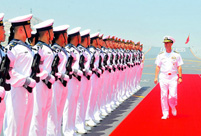


BEIJING, Aug. 8 -- China's exports climbed at a faster pace in July, while a decline in imports accelerated, in a sign of continued weakness in the world's second-largest economy.
Exports in yuan-denominated terms rose 2.9 percent year on year in July, an improvement from June's 1.3-percent increase. Imports fell 5.7 percent, accelerating from a decline of 2.3 percent in June, according to figures from the General Administration of Customs (GAC) on Monday.
This led to a monthly trade surplus of 342.8 billion yuan (51.5 billion U.S. dollars), up 34 percent from one year earlier.
In U.S. dollar-terms, China's exports contracted 4.4 percent year on year in July, a slight improvement over June's 4.8-percent contraction. Imports were down 12.5 percent, accelerating from June's decline of 8.4 percent.
CICC analyst Liu Liu said a 6-percent depreciation of the yuan against a basket of currencies over the past year has boosted exports to some extent, but there is still significant uncertainty about external demand.
Export growth may stay low in the second half of the year, Liu said.
The accelerating fall in imports came amid weak commodity prices and higher comparative base from last year, but it also suggested domestic economic activity remained weak, said Jiang Chao, an analyst with Haitong Securities. Jiang expected the exchange rate of the yuan to remain stable in short term.
Foreign trade in the first seven months was 3 percent lower than a year before, with exports down 1.6 percent and imports down 4.8 percent.
Trade surplus for the first seven months widened 8.7 percent from one year earlier to 1.99 trillion yuan.
The GAC expects pressure on exports to start to ease in October.
China's economy held steady at 6.7 percent in the second quarter of the year, the lowest quarterly level since the dark days of the global financial crisis in early 2009 but still within the government's target range of 6.5-7 percent for 2016.
Stubbornly soft global demand and overcapacity have weighed on China's manufacturing sector, turning it from a drive to drag of growth. Policy makers have been trying to encourage innovation and push forward supply-side reform to sustain economic growth.
Factory activity surveys released last week showed both export and domestic orders cooled in July, as widespread flooding in some regions disrupted business.
The purchasing managers' index (PMI) came in at 49.9 in July, slightly lower than June's 50. A reading above 50 indicates expansion, while a reading below 50 reflects contraction.
China's iron ore imports rose 8.1 percent by volume in the first seven months, while that of crude oil and coal surged 12.1 percent and 6.7 percent, respectively.
Foreign trade with the European Union, China's biggest trade partner, climbed 1.8 percent year on year in the first seven months, GAC data showed.
In the same period, foreign trade with the United States, China's second-biggest trade partner, fell 4.8 percent and with ASEAN, its third-largest trade partner, declined 2.2 percent.
 Spectacular bridge with one of the tallest piers in the world
Spectacular bridge with one of the tallest piers in the world Magnificent view of Hukou Waterfall
Magnificent view of Hukou Waterfall A glimpse of Stride 2016 Zhurihe B military drill
A glimpse of Stride 2016 Zhurihe B military drill US Navy chief tours Liaoning aircraft carrier
US Navy chief tours Liaoning aircraft carrier Chinese American woman wins Miss Michigan
Chinese American woman wins Miss Michigan Centenarian couple takes first wedding photos
Centenarian couple takes first wedding photos Traditional Tibetan costumes presented during fashion show
Traditional Tibetan costumes presented during fashion show How did ancient people escape the summer heat
How did ancient people escape the summer heat Breathtaking scenery of Hulun Buir grassland
Breathtaking scenery of Hulun Buir grassland Top 10 livable Chinese cities
Top 10 livable Chinese cities Top 20 hottest women in the world in 2014
Top 20 hottest women in the world in 2014 Top 10 hardest languages to learn
Top 10 hardest languages to learn China’s Top 10 Unique Bridges, Highways and Roads
China’s Top 10 Unique Bridges, Highways and Roads Risk management key to peace at sea
Risk management key to peace at sea  Wannabe actors in China's Hollywood
Wannabe actors in China's Hollywood  Horton displays no goodwill in remarks over his rival
Horton displays no goodwill in remarks over his rival  China’s athletes in Brazil only dine on meals prepared by Chinese chefs
China’s athletes in Brazil only dine on meals prepared by Chinese chefs Day|Week